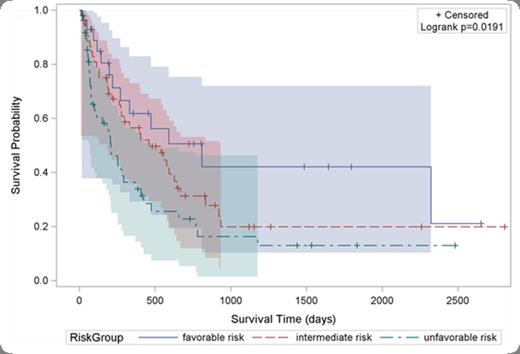Abstract
Insurance status has been found to affect treatment outcomes in various solid tumors. However, less data is available in patients with acute myeloid leukemia (AML). We conducted a comprehensive retrospective analysis to further investigate whether insurance status affects treatment outcomes in AML patients. Our analyses evolved to explore the role potential biochemical and clinical pre-treatment variables play in affecting treatment outcomes and predicting known cytogenetic risk groups.
From 2000 to 2011 we identified 269 patients with AML at The University of Oklahoma Health Sciences Center. A total of 217 patients with usable medical records were included in the final analysis. In the study, 28 pretreatment variables were examined to assess their effect on prognosis in terms of treatment outcomes and their ability to predict cytogenetic/molecular risk status. Cytogenetic risk groups were created based on the National Comprehensive Cancer Network (NCCN) guidelines algorithm. Primary outcomes were complete remission (CR), relapse, and overall survival (OS) rates. In order to assess survival, Kaplan-Meier curves and log rank tests of equality were performed on categorical variables. Cox proportional hazard models were used to assess continuous variables. A multivariate Cox proportional hazard model was created to explore associations between overall survival times with all covariates. Pre-treatment variables were then used to predict cytogenetic risk status using a multinomial logistic regression.
Of the 217 patients (52.2% males, 47.8% females) included in the study, 81.5% were white, 9.0% African American, and 6.2% Native American. Median age at diagnosis was 51.0 years. 36.3% had private insurance, 45.8% had public insurance, and 17.3% were uninsured. There was no significant association found between insurance status and treatment outcomes (CR, OS, and relapse rates).
Cytogenetic risk status was independently associated with insurance status (table 1). Cytogenetic risk status was also significantly related to complete remission (p=0.0007), status at last follow up (p = 0.0405), and overall survival (p = 0.0002 for better-risk and p < 0.0001 for intermediate-risk, compared to poor-risk group).
Chi-Square Values for Cytogenetic (Risk) Groups by Insurance Status
| . | Insurance . | Better-risk . | Intermediate-risk . | Poor-risk . | P-Value . |
|---|---|---|---|---|---|
| Insurance Type | Public Private Uninsured | 14 (48.3) 11 (37.9) 4 (13.8) | 18 (32.1) 23 (41.1) 15 (26.8) | 30 (53.6) 22 (39.3) 4 (7.1) | 0.0422* |
| . | Insurance . | Better-risk . | Intermediate-risk . | Poor-risk . | P-Value . |
|---|---|---|---|---|---|
| Insurance Type | Public Private Uninsured | 14 (48.3) 11 (37.9) 4 (13.8) | 18 (32.1) 23 (41.1) 15 (26.8) | 30 (53.6) 22 (39.3) 4 (7.1) | 0.0422* |
Among 28 tested variables, we found 3 factors significantly predict cytogenetic/molecular risk status. Having the better-risk group as the reference group, diabetes (OR-12.7, 95% CI = 1.44-111.7) and elevated creatinine (OR- 0.07, 95% CI = 0.0-0.95) were predictive for intermediate-risk, where as diabetes (OR-6.9, 95% CI = 1.07-44.8) and elevated uric acid (OR- 0.60, 95% CI = 0.39-0.91) were predictive for poor-risk group.
Based on cytogenetic and molecular classification, our results on survival analysis are consistent with previous reported studies (figure 1). There was no association between treatment outcomes and insurance status. Among the 28 pretreatment variables studied, we found that diabetes, uric acid, and creatinine might be useful markers in predicting cytogenetic risk category. This could aid in risk-adaptive treatment plans before cytogenetic tests become available or tests prove to be unfeasible to be done. Larger studies are needed to corroborate our findings.
Survival Curves with 95% CI by Risk Group
No relevant conflicts of interest to declare.
Author notes
Asterisk with author names denotes non-ASH members.


